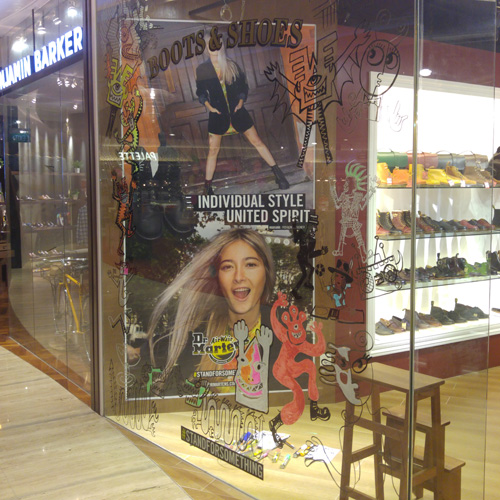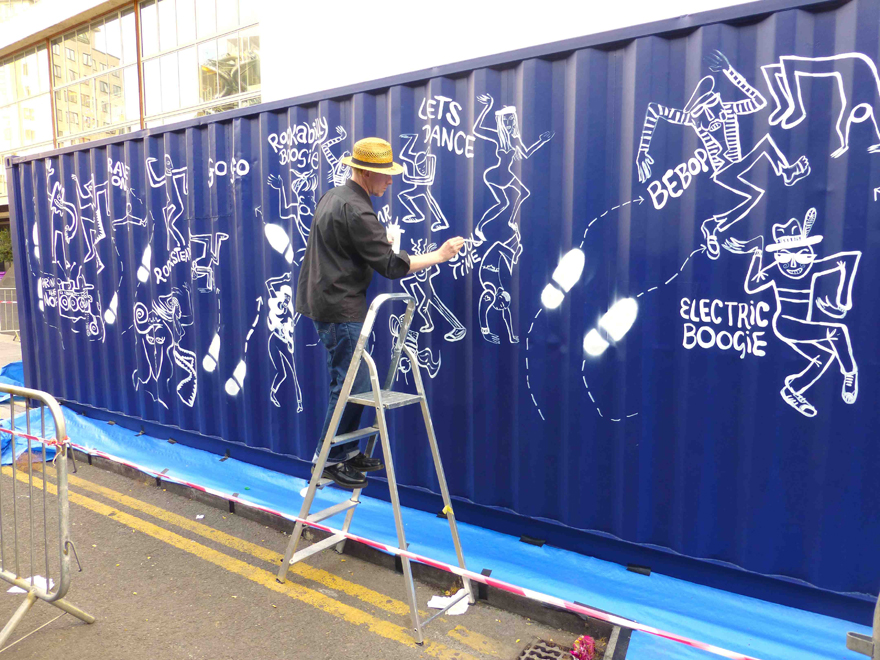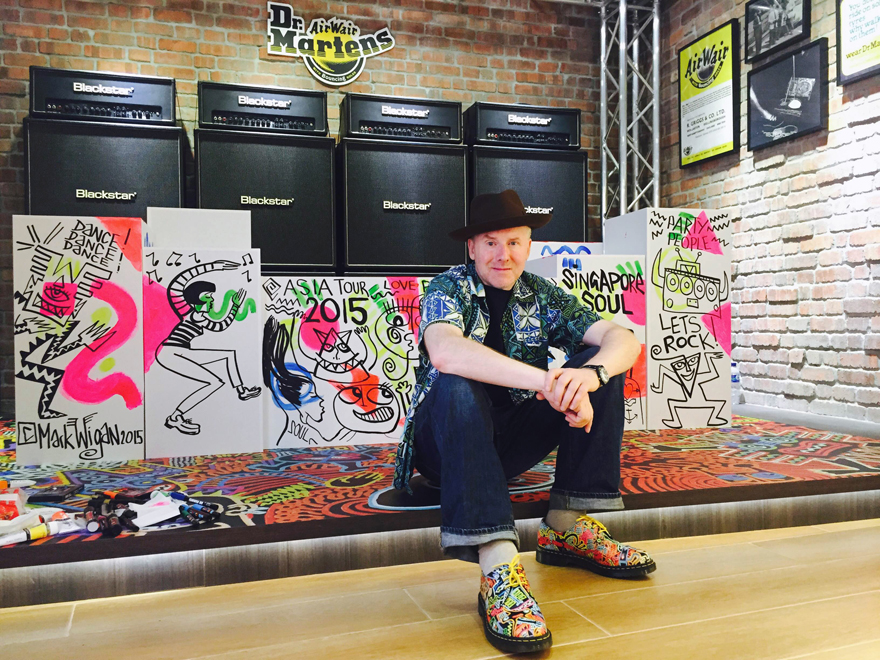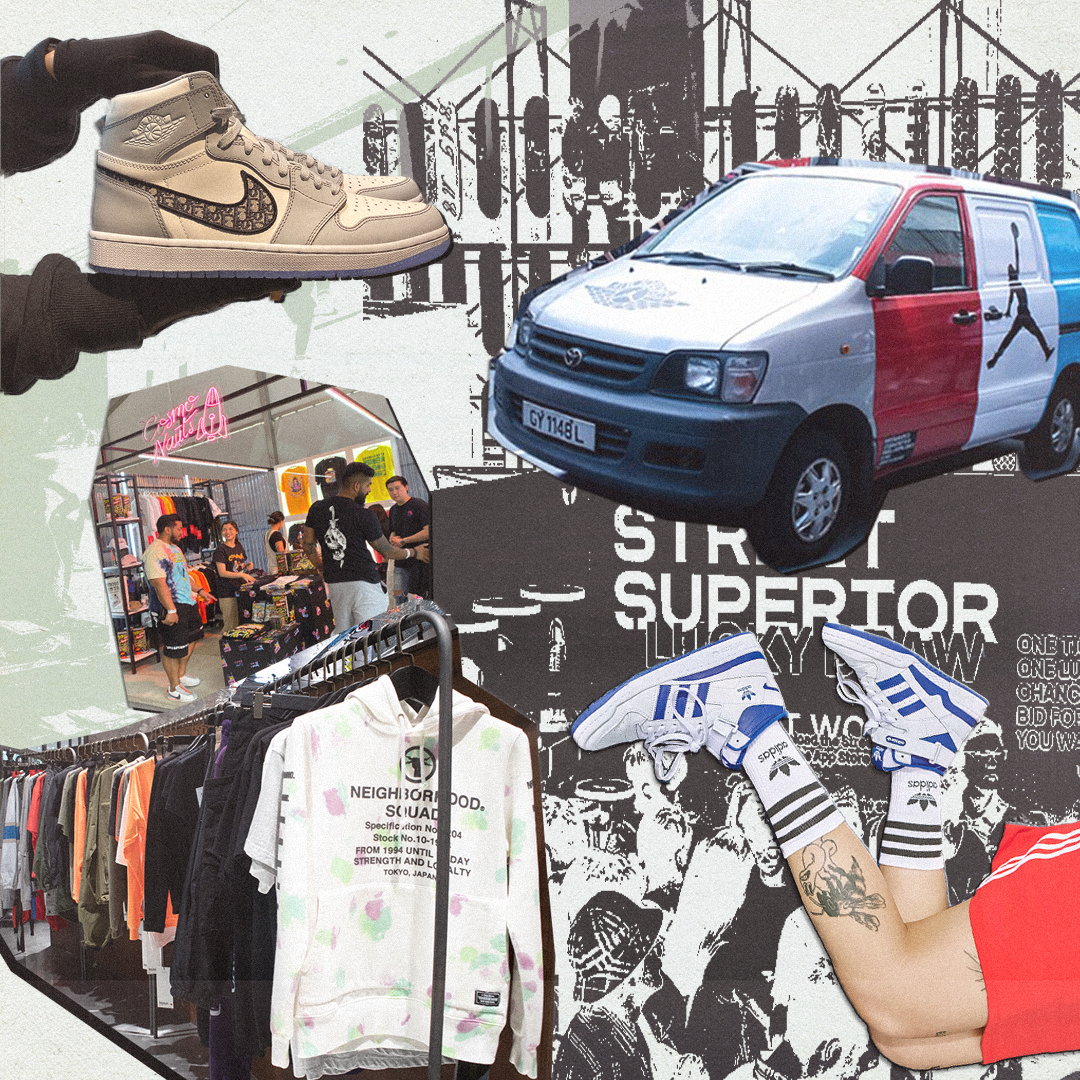Sign up for trending news and first dibs
15 Questions with UK Graphic Artist Mark Wigan
15 Questions with UK Graphic Artist Mark Wigan
Mark Wigan, an artist whose career has spanned 30 years, has traveled the world and rubbed shoulders with personalities like Andy Warhol, Keith Haring and Grace Jones. We spoke to him ahead of the launch of his collaboration with Dr. Martens in Singapore.
When was your first brush with art and how did you know this was going to be your career?
I was drawing from the age of three and art was always my top subject at school. It was inevitable that I would go from school to art college. I’ve always had the drive to be an artist and I’ve always known that my life was gonna be about art.
Some artists stick to just one medium, like canvas. You, on the other hand, have worked on a variety of media throughout your career.
Art is divided into categories by society, so you can say my work crosses between contemporary fine arts, urban/street arts and illustrations. At the basis of it all is drawing from my visual language. The drawings and paintings can be used in different mediums, like a Dr. Martens boot or a t-shirt. As an artist, I like the idea of my work being accessible to people and not just being on a gallery wall.
Which media are challenging?
This window installation that I’m working on now is quite a challenge, because I’m using water-based markers to paint on glass. It’s the first time I’ve worked on a window, and I’m painting from behind the window, so the resulting art is reversed. I have to keep going around to the storefront to see it.
What are some notable works that stand out in your memory?
I painted a 100-meter-long mural in Nagoya, Japan, which took about a week to complete. I once worked on a cinema in London – the Scala over at King’s Cross – and I painted the ceiling and all the walls. That took one month.

Mark’s hieroglyphic-like work over at Dr. Martens’ Capitol Piazza store
Having been in the scene since the ’80s, what are your thoughts on the evolution of urban arts?
I like urban art when it is innovative and not imitative. There are a lot of imitators around in the urban arts area and some of the work can be formulaic. But there’s some great work coming out of Brazil, South America and Paris, not forgetting the guys in UK like Banksy and D*Face.
How do you prevent yourself from going down the path of being formulaic?
Travel has always been great; for this Asian tour I’ve been to Seoul, Tokyo, Hong Kong and now Singapore. I take inspiration from the different cities that I’m in. I like to look at the history and where the old buildings are, especially in Asia. So many of these countries are being developed real quickly and we are losing the heart and soul of the cities. Sadly, we are losing a lot of nature too. I also look out for developments by young artists and fashion designers. It’s part of my mission to encourage them to be creative. I often check out the nightlife and hear the music.
Tell us more about your relationship with Andy Warhol.
Andy Warhol saw a mural that I painted in London’s Limelight Club back in 1986, and complimented me on my work, saying it was “hot”. He introduced me to the club’s owner, Peter Gatien, and recommended me to paint at its New York branch. Andy also put me through to artist Keith Haring and I visited his studio above Tower Records. I asked Keith if he would host my exhibition at the Limelight Club, and though he wasn’t available to do that, I did get a lot of famous people coming down. Personalities like Jamaican model Grace Jones, Blondie’s lead singer Debbie Harry, writer Quentin Crisp, who inspired the song “Englishman in New York” by Sting, and even Mike Tyson back in his heyday. That was the thing about New York in the ’80s. The people that came to the clubs were from different fields, whether it was movies, music or sports, they came together in the club scene.
Your work is visually complex and multi-layered. When do you actually take a step back and say, “Alright, this artwork is complete”?
I leave room for improvisation and spontaneity; every artwork that I’ve done is slightly different from each other. I refrain from being repetitive and I put myself in situations where I work against the constraints of the surface and the technique. I have to listen to music when I work and that helps with the improvisation.

Whether it’s canvas, a glass window or a metal container, Mark has painted them all (Image via Mark Wigan)
We imagine that you listen to a diverse range of music.
My taste in music started with the Northern soul scene in the UK. There’s an uptempo, motown beat made by lots of obscure artists who never really became famous. I collect vinyl records from that period. Because I was very involved in the club scene, I would listen to anything from house to techno. But usually when I’m working in the studio, I like to listen to soul or early R&B from the ’40s to the ’60s.
As the co-founder and curator of the Museum of Club Culture, how has the culture evolved?
Recently, a lot of nightclubs have started closing down. Young people today have so many different interests, they don’t just go to nightclubs. The licensing laws have changed in the UK, and since then a lot of people have started going to pubs, which stay open later and have a resident DJ. As there are so many citizens living in the city near club venues, they object to the sounds. It’s ironic, because they were attracted to the trendy town areas and got apartments there, but then they don’t want to hear the noise that’s going on all night at the clubs. In a way, it destroys the thing that made the areas the hotspots where people wanted to be.
You also teach illustration in universities. How different are the students of today like?
When I was in college, it was culturally different because it was the post-punk era. We all left home when we were 18, whereas a lot of my students still live with their parents. For us, it wasn’t just about going to school, it was the whole social scene where we would set up our clubs, fanzines. We took a different approach to arts school; these days a lot of people see it as just getting a degree, while we saw it as a way of life that would carry on when we became artists.
How do you encourage these kids?
I always hope that my students will go on to form the next wave of creative personalities. I encourage them to follow their own path and to pour all their interest into their work, so that it is distinctive and truly their own. There’s a lot of give and take, you have to encourage them but at the same time, tell them to work really hard and have discipline, meet deadlines.

One of the many boots that form the Mark Wigan x Dr. Martens collection (Image via Mark Wigan)
Do you feel that the new artists of today have it easier with social media as a tool to get themselves seen and heard?
I think it’s a good communication tool. I started from MySpace and moved on to Facebook, Instagram and LinkedIn. It’s quite a good way of getting your work out there. It’s so easy to get immersed and lost in the Internet, but you have to get work done as well.
You didn’t have this privilege back in the day, but you still made it.
I had to travel to New York and Tokyo with a printed portfolio of my work, have the confidence to meet people and speak to them. It was difficult because I didn’t speak any Japanese and I had to get things going, but it worked out. You have to be quite thick-skinned and be able to persevere. I received my fair share of rejections; some people simply didn’t like my style. But I got my first big break, which was working for i-D magazine.
Last but not least, which artists do you admire?
I still look at artists whose work are enduring. Artists like FAILE, who still continue to do interesting projects, and Banksy, whose latest work is Dismoland. When an artist’s work endures, it’s more interesting. Some people do it for a while and then give up, but if people keep going at it, you will see interesting artistic developments unfolding.
The Mark Wigan x Dr. Martens collection launches in stores (Capitol Piazza, Wheelock Place) today, September 18th. The event is open to public from 8pm to 10pm.
TAGS
Tags:








